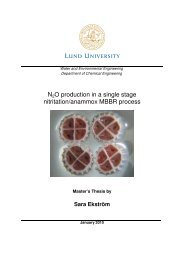Kemira Oyj/Kemira M&I ABSTRACT Vesa Kettunen ... - Svenskt Vatten
Kemira Oyj/Kemira M&I ABSTRACT Vesa Kettunen ... - Svenskt Vatten
Kemira Oyj/Kemira M&I ABSTRACT Vesa Kettunen ... - Svenskt Vatten
Create successful ePaper yourself
Turn your PDF publications into a flip-book with our unique Google optimized e-Paper software.
Abstract for:<br />
13 th Nordic Wastewater Conference<br />
To be considered in all categories<br />
Title:<br />
Laboratory and field investigation of Chemical disinfection of sewer overflow in<br />
Copenhagen Area<br />
Authors:<br />
Henrik R. Andersen, DTU Miljø, hran@env.dtu.dk<br />
Anitha K. Sharma , DTU Miljø<br />
Ravi K. Chhetri , DTU Miljø<br />
Jesper Berner, KEMIRA<br />
Robin Gramstad KEMIRA<br />
Öjstedt Ulrik KEMIRA<br />
Dines Thornberg, Udviklingssamarbejdet.<br />
Kasper Juel-Berg , HOFOR<br />
Annette Kolte-Olsen , Nordvand<br />
Jean De Dieu Otoa , Greve-Solrød forsyning<br />
Abstract<br />
Combined Sewer Overflow (CSO) has been a problem in every large city with old sewers resulting in<br />
deterioration of water quality of receiving waters around the city. . With the anticipated increased rain<br />
intensity due to climate change and increased loads on sewer system due to urbanisation the problem is<br />
expected to be magnified in the future. Copenhagen has many beaches and several public baths in the old<br />
harbour and to maintain the high water quality for bathing it is necessary to reduce the microbial pollution<br />
from the CSOs.<br />
Disinfection of CSOs reduces the load of microorganisms and the most common methods are UV-light or<br />
addition of different forms of chlorine. However, UV-disinfection of CSOs is not attractive due to high<br />
capital cost and non-predictive occurrence of CSOs. Disinfection with chlorine forms toxic by-products. In<br />
recent years, laboratory and full scale investigation of novel organoperoxide disinfectants, peracetic<br />
acid(PAA) and performic acid(PFA) have shown that these chemicals can be attractive disinfectants. We<br />
presents results from laboratory and field investigations on disinfection of CSOs using PFA and PAA.<br />
The laboratory part of the study aims to produce the relevant information in order to find the most suitable<br />
chemical disinfections agents for CSOs in different contexts: Concentration profiles, disinfection efficiency,<br />
byproducts and residual toxicity is investigated. Additionally a literature study is performed to describe the<br />
costs and handling of each chemical. The project, “DesiCSO”, partly funded by Vand-i-Byer and will be<br />
finished in March 2013.<br />
The field investigations will be performed at 3 different sites with the aim to investigate whether it is<br />
possible to obtain bathing water shortly after heavy rainstorms in full-scale. The project named FRODO,
















